Abstract
We report here on the ability of IDRA 21 and aniracetam, two negative allosteric modulators of glutamate-induced DL-alpha-amino-3-hydroxy-5-methyl-4-isoxazolepropionic acid (AMPA) receptor desensitization, to attenuate alprazolam-induced learning deficit in patas monkeys working in a complex behavioral task. In one component of a multiple schedule (repeated acquisition or "learning"), patas monkeys acquired a different four-response chain each session by responding sequentially on three keys in the presence of four discriminative stimuli (geometric forms or numerals). In the other component (performance) the four-response chain was the same each session. The response chain in each component was maintained by food presentation under a fixed-ratio schedule. When alprazolam (0.1 or 0.32 mg/kg p.o.) was administered alone, this full allosteric modulator of gamma-aminobutyric acid type A (GABAA) receptors produced large decreases in the response rate and accuracy in the learning component of the task. IDRA 21 (3 or 5.6 mg/kg p.o.) and aniracetam (30 mg/kg p.o.) administered 60 min before alprazolam, having no effect when given alone, antagonized the large disruptive effects of alprazolam on learning. From dose-response studies, it can be estimated that IDRA 21 is approximately 10-fold more potent than aniracetam in antagonizing alprazolam-induced learning deficit. We conclude that IDRA 21, a chemically unrelated pharmacological congener of aniracetam, improves learning deficit induced in patas monkeys by the increase of GABAergic tone elicited by alprazolam. Very likely IDRA 21 exerts its behavioral effects by antagonizing AMPA receptor desensitization.
Full text
PDF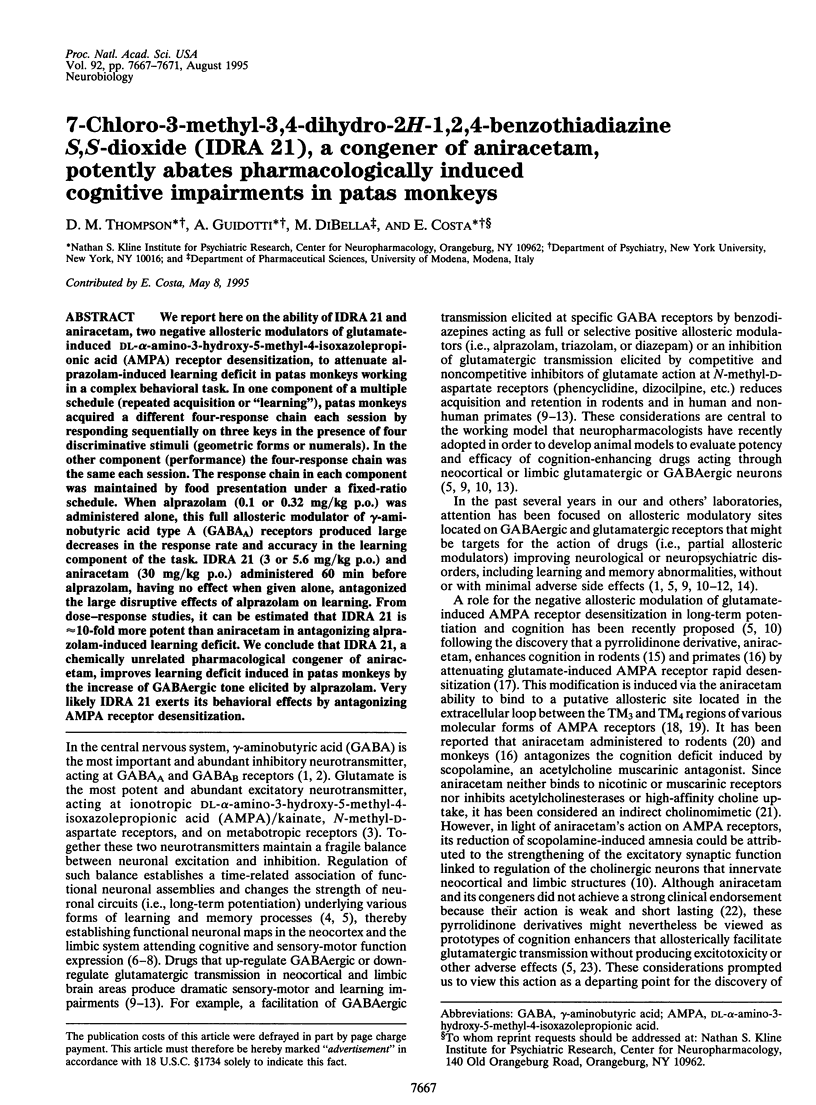
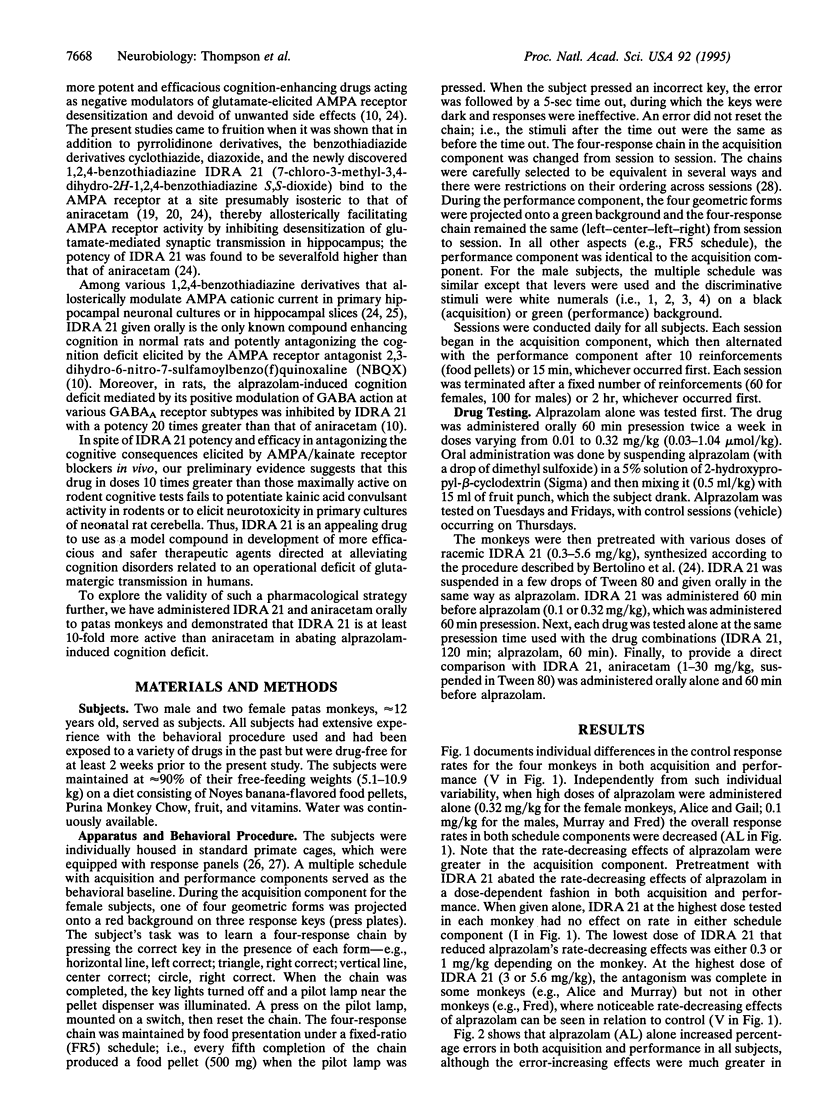
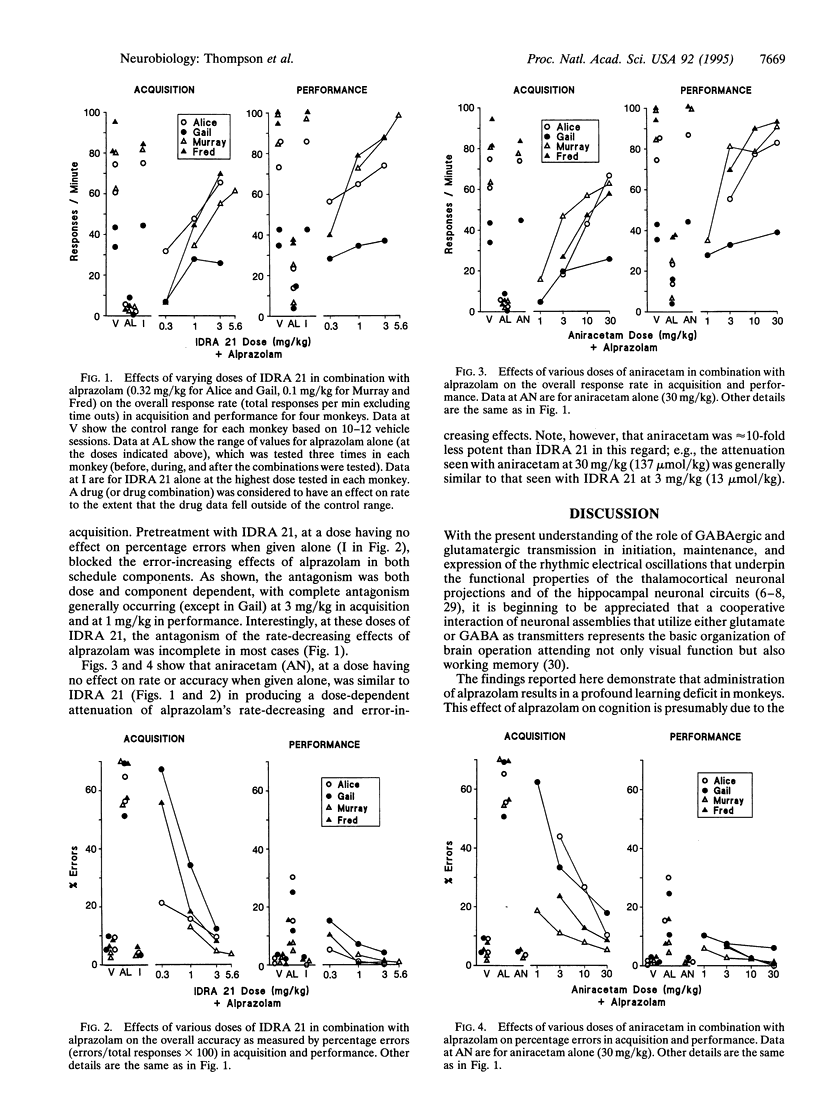
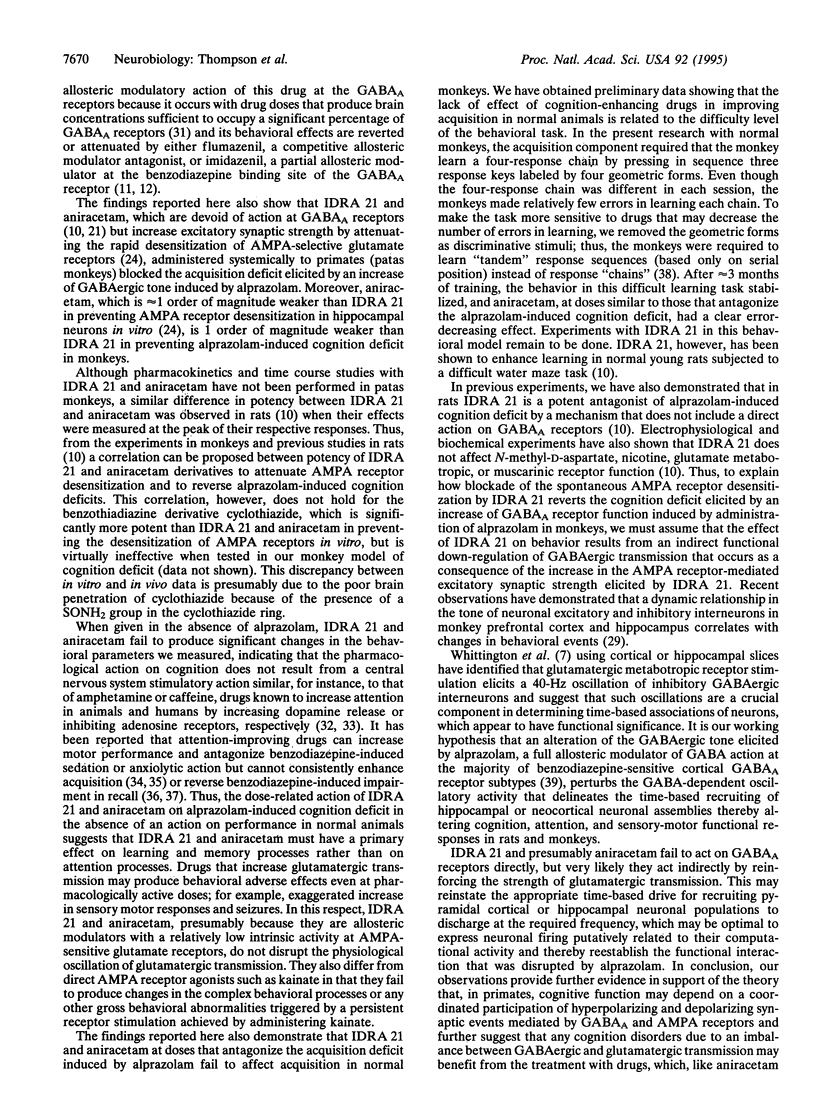
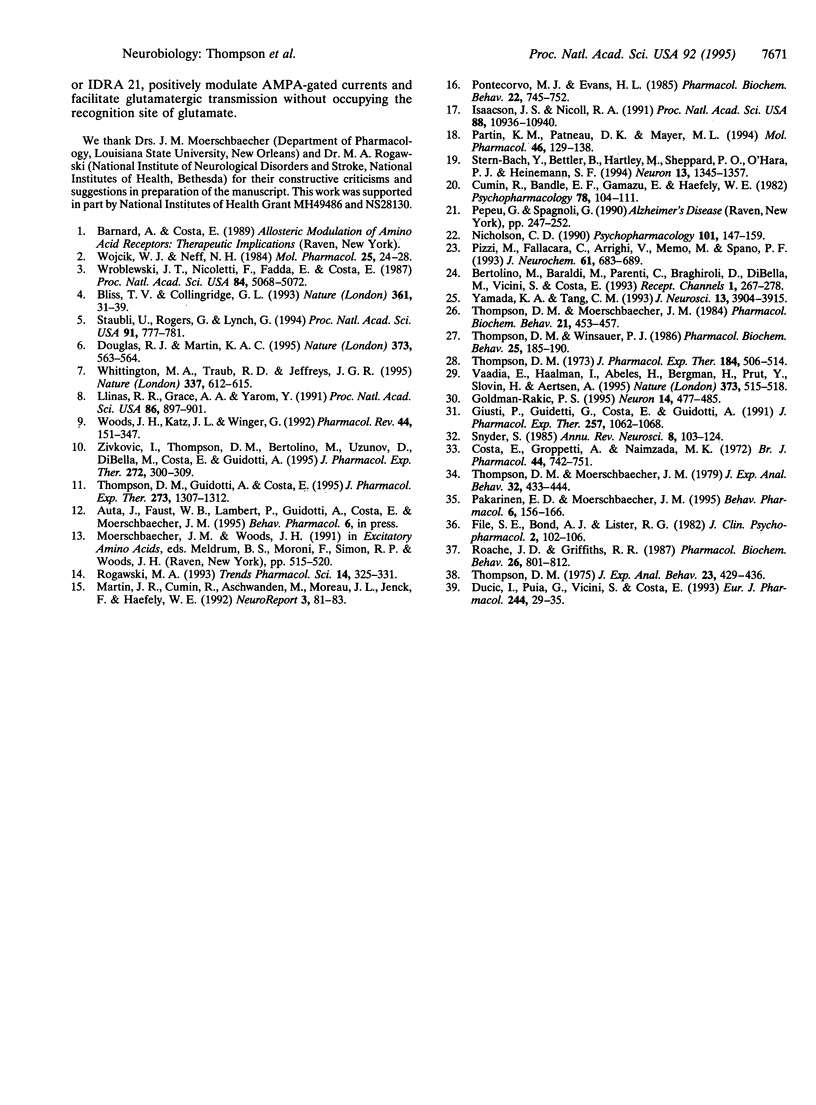
Selected References
These references are in PubMed. This may not be the complete list of references from this article.
- Bertolino M., Baraldi M., Parenti C., Braghiroli D., DiBella M., Vicini S., Costa E. Modulation of AMPA/kainate receptors by analogues of diazoxide and cyclothiazide in thin slices of rat hippocampus. Receptors Channels. 1993;1(4):267–278. [PubMed] [Google Scholar]
- Bliss T. V., Collingridge G. L. A synaptic model of memory: long-term potentiation in the hippocampus. Nature. 1993 Jan 7;361(6407):31–39. doi: 10.1038/361031a0. [DOI] [PubMed] [Google Scholar]
- Costa E., Groppetti A., Naimzada M. K. Effects of amphetamine on the turnover rate of brain catecholamines and motor activity. Br J Pharmacol. 1972 Apr;44(4):742–751. doi: 10.1111/j.1476-5381.1972.tb07312.x. [DOI] [PMC free article] [PubMed] [Google Scholar]
- Cumin R., Bandle E. F., Gamzu E., Haefely W. E. Effects of the novel compound aniracetam (Ro 13-5057) upon impaired learning and memory in rodents. Psychopharmacology (Berl) 1982;78(2):104–111. doi: 10.1007/BF00432244. [DOI] [PubMed] [Google Scholar]
- Douglas R. J., Martin K. A. Neuronal networks. Vibrations in the memory. Nature. 1995 Feb 16;373(6515):563–564. doi: 10.1038/373563a0. [DOI] [PubMed] [Google Scholar]
- Ducić I., Puia G., Vicini S., Costa E. Triazolam is more efficacious than diazepam in a broad spectrum of recombinant GABAA receptors. Eur J Pharmacol. 1993 Jan 4;244(1):29–35. doi: 10.1016/0922-4106(93)90056-f. [DOI] [PubMed] [Google Scholar]
- File S. E., Bond A. J., Lister R. G. Interaction between effects of caffeine and lorazepam in performance tests and self-ratings. J Clin Psychopharmacol. 1982 Apr;2(2):102–106. [PubMed] [Google Scholar]
- Giusti P., Guidetti G., Costa E., Guidotti A. The preferential antagonism of pentylenetetrazole proconflict responses differentiates a class of anxiolytic benzodiazepines with potential antipanic action. J Pharmacol Exp Ther. 1991 Jun;257(3):1062–1068. [PubMed] [Google Scholar]
- Goldman-Rakic P. S. Cellular basis of working memory. Neuron. 1995 Mar;14(3):477–485. doi: 10.1016/0896-6273(95)90304-6. [DOI] [PubMed] [Google Scholar]
- Isaacson J. S., Nicoll R. A. Aniracetam reduces glutamate receptor desensitization and slows the decay of fast excitatory synaptic currents in the hippocampus. Proc Natl Acad Sci U S A. 1991 Dec 1;88(23):10936–10940. doi: 10.1073/pnas.88.23.10936. [DOI] [PMC free article] [PubMed] [Google Scholar]
- Llinás R. R., Grace A. A., Yarom Y. In vitro neurons in mammalian cortical layer 4 exhibit intrinsic oscillatory activity in the 10- to 50-Hz frequency range. Proc Natl Acad Sci U S A. 1991 Feb 1;88(3):897–901. doi: 10.1073/pnas.88.3.897. [DOI] [PMC free article] [PubMed] [Google Scholar]
- Martin J. R., Cumin R., Aschwanden W., Moreau J. L., Jenck F., Haefely W. E. Aniracetam improves radial maze performance in rats. Neuroreport. 1992 Jan;3(1):81–83. doi: 10.1097/00001756-199201000-00021. [DOI] [PubMed] [Google Scholar]
- Nicholson C. D. Pharmacology of nootropics and metabolically active compounds in relation to their use in dementia. Psychopharmacology (Berl) 1990;101(2):147–159. doi: 10.1007/BF02244119. [DOI] [PubMed] [Google Scholar]
- Pakarinen E.D., Moerschbaecher J.M. Effects of competitive and noncompetitive GABA(A) antagonists on the acquisition of a discrimination in squirrel monkeys. Behav Pharmacol. 1995 Mar;6(2):156–166. [PubMed] [Google Scholar]
- Partin K. M., Patneau D. K., Mayer M. L. Cyclothiazide differentially modulates desensitization of alpha-amino-3-hydroxy-5-methyl-4-isoxazolepropionic acid receptor splice variants. Mol Pharmacol. 1994 Jul;46(1):129–138. [PubMed] [Google Scholar]
- Pepeu G., Spignoli G. Neurochemical actions of "nootropic drugs". Adv Neurol. 1990;51:247–252. [PubMed] [Google Scholar]
- Pizzi M., Fallacara C., Arrighi V., Memo M., Spano P. F. Attenuation of excitatory amino acid toxicity by metabotropic glutamate receptor agonists and aniracetam in primary cultures of cerebellar granule cells. J Neurochem. 1993 Aug;61(2):683–689. doi: 10.1111/j.1471-4159.1993.tb02173.x. [DOI] [PubMed] [Google Scholar]
- Pontecorvo M. J., Evans H. L. Effects of aniracetam on delayed matching-to-sample performance of monkeys and pigeons. Pharmacol Biochem Behav. 1985 May;22(5):745–752. doi: 10.1016/0091-3057(85)90523-4. [DOI] [PubMed] [Google Scholar]
- Roache J. D., Griffiths R. R. Interactions of diazepam and caffeine: behavioral and subjective dose effects in humans. Pharmacol Biochem Behav. 1987 Apr;26(4):801–812. doi: 10.1016/0091-3057(87)90614-9. [DOI] [PubMed] [Google Scholar]
- Rogawski M. A. Therapeutic potential of excitatory amino acid antagonists: channel blockers and 2,3-benzodiazepines. Trends Pharmacol Sci. 1993 Sep;14(9):325–331. doi: 10.1016/0165-6147(93)90005-5. [DOI] [PubMed] [Google Scholar]
- Snyder S. H. Adenosine as a neuromodulator. Annu Rev Neurosci. 1985;8:103–124. doi: 10.1146/annurev.ne.08.030185.000535. [DOI] [PubMed] [Google Scholar]
- Staubli U., Rogers G., Lynch G. Facilitation of glutamate receptors enhances memory. Proc Natl Acad Sci U S A. 1994 Jan 18;91(2):777–781. doi: 10.1073/pnas.91.2.777. [DOI] [PMC free article] [PubMed] [Google Scholar]
- Stern-Bach Y., Bettler B., Hartley M., Sheppard P. O., O'Hara P. J., Heinemann S. F. Agonist selectivity of glutamate receptors is specified by two domains structurally related to bacterial amino acid-binding proteins. Neuron. 1994 Dec;13(6):1345–1357. doi: 10.1016/0896-6273(94)90420-0. [DOI] [PubMed] [Google Scholar]
- Thompson D. M., Auta J., Guidotti A., Costa E. Imidazenil, a new anxiolytic and anticonvulsant drug, attenuates a benzodiazepine-induced cognition deficit in monkeys. J Pharmacol Exp Ther. 1995 Jun;273(3):1307–1312. [PubMed] [Google Scholar]
- Thompson D. M., Moerschbaecher J. M. An experimental analysis of the effects of d-amphetamine and cocaine on the acquisition and performance of response chains in monkeys. J Exp Anal Behav. 1979 Nov;32(3):433–444. doi: 10.1901/jeab.1979.32-433. [DOI] [PMC free article] [PubMed] [Google Scholar]
- Thompson D. M., Moerschbaecher J. M. Differential effects of phencyclidine and MDA on complex operant behavior in monkeys. Pharmacol Biochem Behav. 1984 Sep;21(3):453–457. doi: 10.1016/s0091-3057(84)80109-4. [DOI] [PubMed] [Google Scholar]
- Thompson D. M. Repeated acquisition as a behavioral base line for studying drug effects. J Pharmacol Exp Ther. 1973 Feb;184(2):506–514. [PubMed] [Google Scholar]
- Thompson D. M. Repeated acquisition of response sequences: stimulus control and drugs. J Exp Anal Behav. 1975 May;23(3):429–436. doi: 10.1901/jeab.1975.23-429. [DOI] [PMC free article] [PubMed] [Google Scholar]
- Thompson D. M., Winsauer P. J. Nicotine can attenuate the disruptive effects of phencyclidine on repeated acquisition in monkeys. Pharmacol Biochem Behav. 1986 Jul;25(1):185–190. doi: 10.1016/0091-3057(86)90251-0. [DOI] [PubMed] [Google Scholar]
- Vaadia E., Haalman I., Abeles M., Bergman H., Prut Y., Slovin H., Aertsen A. Dynamics of neuronal interactions in monkey cortex in relation to behavioural events. Nature. 1995 Feb 9;373(6514):515–518. doi: 10.1038/373515a0. [DOI] [PubMed] [Google Scholar]
- Whittington M. A., Traub R. D., Jefferys J. G. Synchronized oscillations in interneuron networks driven by metabotropic glutamate receptor activation. Nature. 1995 Feb 16;373(6515):612–615. doi: 10.1038/373612a0. [DOI] [PubMed] [Google Scholar]
- Wojcik W. J., Neff N. H. gamma-aminobutyric acid B receptors are negatively coupled to adenylate cyclase in brain, and in the cerebellum these receptors may be associated with granule cells. Mol Pharmacol. 1984 Jan;25(1):24–28. [PubMed] [Google Scholar]
- Woods J. H., Katz J. L., Winger G. Benzodiazepines: use, abuse, and consequences. Pharmacol Rev. 1992 Jun;44(2):151–347. [PubMed] [Google Scholar]
- Wroblewski J. T., Nicoletti F., Fadda E., Costa E. Phencyclidine is a negative allosteric modulator of signal transduction at two subclasses of excitatory amino acid receptors. Proc Natl Acad Sci U S A. 1987 Jul;84(14):5068–5072. doi: 10.1073/pnas.84.14.5068. [DOI] [PMC free article] [PubMed] [Google Scholar]
- Yamada K. A., Tang C. M. Benzothiadiazides inhibit rapid glutamate receptor desensitization and enhance glutamatergic synaptic currents. J Neurosci. 1993 Sep;13(9):3904–3915. doi: 10.1523/JNEUROSCI.13-09-03904.1993. [DOI] [PMC free article] [PubMed] [Google Scholar]
- Zivkovic I., Thompson D. M., Bertolino M., Uzunov D., DiBella M., Costa E., Guidotti A. 7-Chloro-3-methyl-3-4-dihydro-2H-1,2,4 benzothiadiazine S,S-dioxide (IDRA 21): a benzothiadiazine derivative that enhances cognition by attenuating DL-alpha-amino-2,3-dihydro-5-methyl-3-oxo-4-isoxazolepropanoic acid (AMPA) receptor desensitization. J Pharmacol Exp Ther. 1995 Jan;272(1):300–309. [PubMed] [Google Scholar]


